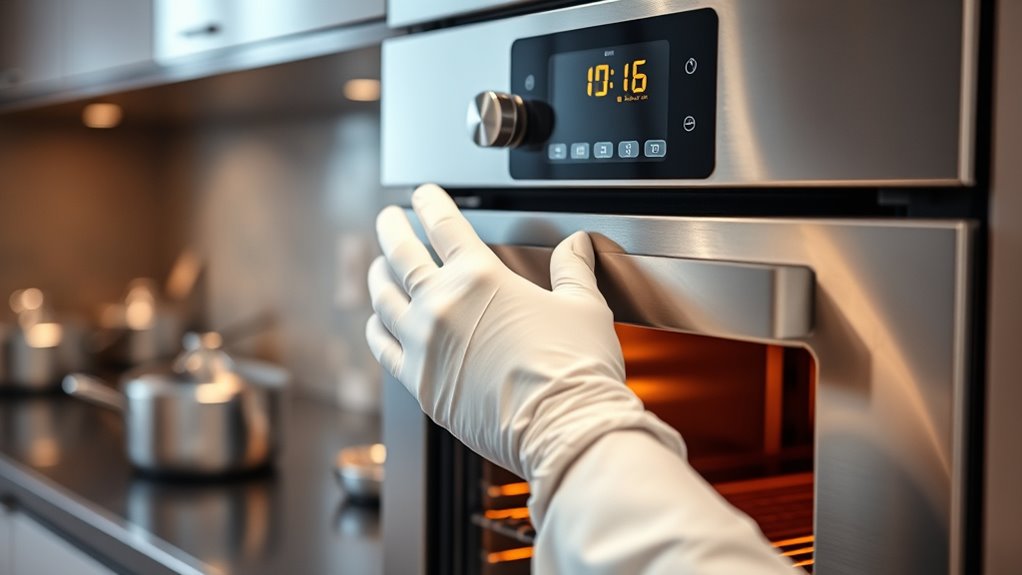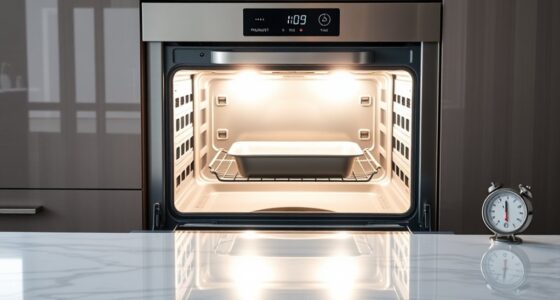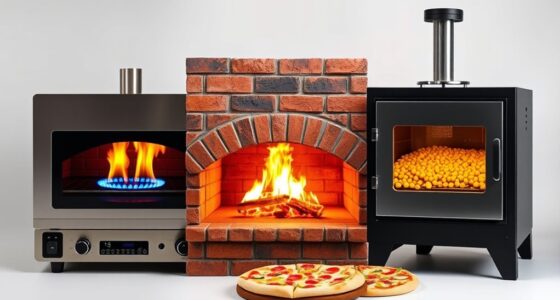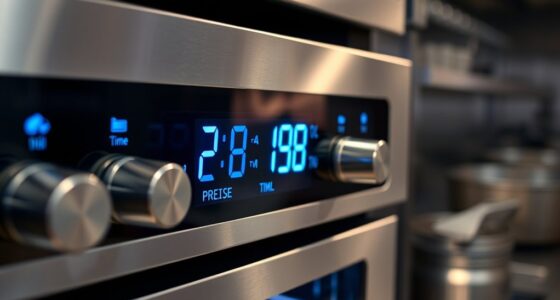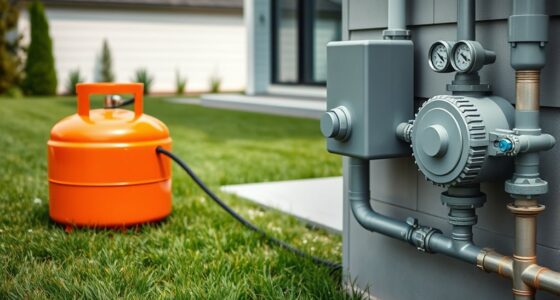Many believe preheating can be skipped or is unnecessary, but in reality, it’s vital for even cooking and safety. Most ovens need about 10-15 minutes to reach the right temperature, confirmed by indicator signals or a thermometer. Rushing this step can cause uneven results and even damage your oven over time. If you want to guarantee safe, efficient, and perfect cooking, understanding the facts will help you get the most out of your oven.
Key Takeaways
- Proper preheating typically takes 10-15 minutes and ensures even cooking and optimal oven performance.
- Visual cues and indicator signals confirm when the oven has reached the desired temperature.
- Using a calibrated thermometer provides precise temperature confirmation during preheating.
- Skipping preheat can cause uneven cooking, increased energy use, and potential oven damage.
- Always stay attentive and avoid leaving the oven unattended during preheating for safety.
Common Misconceptions About Oven Preheating
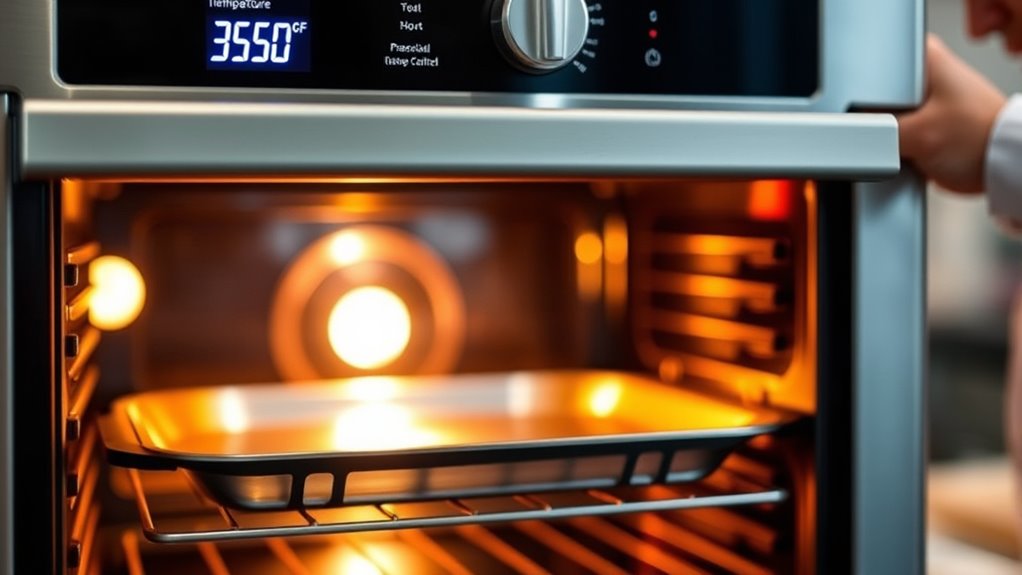
Many people believe that preheating an oven is unnecessary or can be skipped altogether, but this is a common misconception. Proper preheating ensures the oven reaches the correct oven temperature needed for your recipe, which is essential for consistent results. Skipping or rushing the preheating process can lead to uneven cooking or undercooked food. The preheating duration varies depending on your oven and the desired oven temperature, but it’s generally recommended to wait until the oven signals it’s at the right temperature, often indicated by a light or beep. Rushing this step may seem time-saving, but it compromises the quality of your cooking. Trusting your oven’s temperature indicator and allowing adequate preheating time helps ensure your dishes turn out as intended. Seasonal variations can affect how long an oven needs to preheat effectively, especially in colder months.
How Long Should You Really Preheat Your Oven?
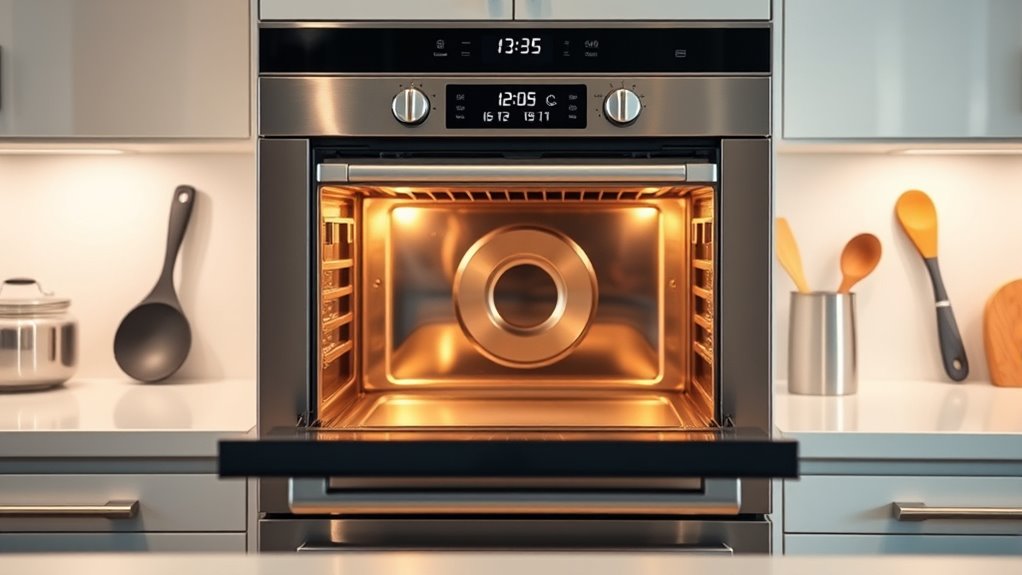
Preheating times can vary depending on your oven’s make and model, as well as the temperature you need for your recipe. Typically, it takes about 10-15 minutes for most ovens to reach the desired heat. To optimize your preheat process:
Preheating times vary; most ovens reach desired heat in 10-15 minutes for optimal baking results.
- Check oven calibration regularly to ensure accurate temperature readings.
- Use an oven thermometer for precise temperature verification.
- Avoid opening the door frequently during preheating, which wastes energy.
- Set the oven to the required temperature at least 10 minutes before baking.
- Remember that proper preheating can improve heat distribution and ensure even cooking.
Proper preheating guarantees even cooking and helps you avoid under or overcooking. It also reduces unnecessary energy consumption caused by prolonged heating. Remember, a well-calibrated oven helps you preheat efficiently and accurately.
Safety Precautions When Using Your Oven

To guarantee safe oven use, always stay attentive while it’s operating, and never leave it unattended during cooking or preheating. Practicing good oven safety helps prevent fire hazards and accidents. Keep flammable items like oven mitts, paper towels, and food packaging away from the heating elements. Regularly check the oven’s interior for grease buildup or food debris, which can ignite. Ensure the oven door seals properly to maintain even heat and avoid uneven heating that could cause overheating. Never attempt to repair the oven yourself; consult a professional if you notice any malfunctions. Always turn off the oven when finished, and allow it to cool before cleaning. Proper oven maintenance and following these precautions minimizes risks and keeps your cooking environment safe.
The Impact of Preheating on Cooking Results
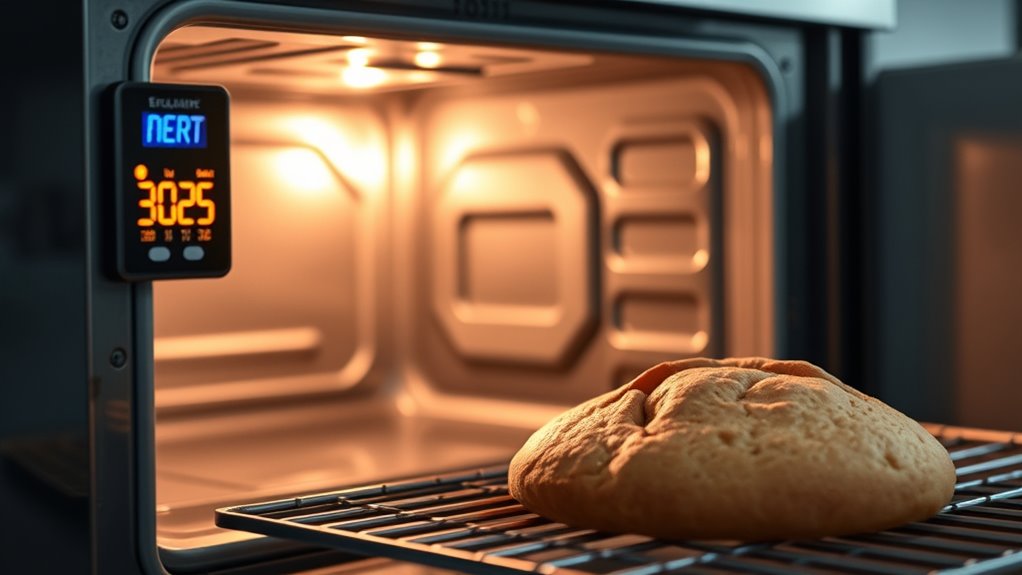
Preheating your oven guarantees it’s at the ideal temperature before you start cooking, which considerably enhances the quality of your results. Proper preheating guarantees oven temperature accuracy, leading to evenly cooked dishes. It also promotes heat distribution consistency, preventing hot or cold spots that can impact texture and doneness. When you preheat correctly, you’re more likely to achieve a crisp crust or tender interior as intended. Additionally, understanding the importance of temperature regulation can help optimize your cooking process for better outcomes.
Myths About Preheat and Oven Efficiency
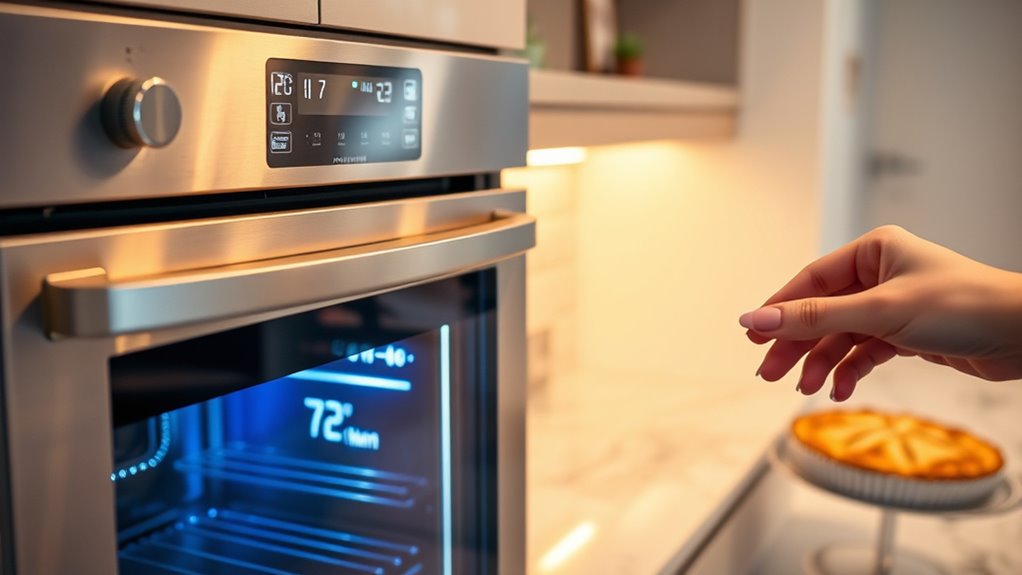
Many people believe that preheating their oven is unnecessary or that it wastes energy, leading to misconceptions about efficiency. They think skipping preheat saves power and improves oven maintenance. However, preheating assures even temperatures, which reduces cooking errors and prevents uneven heating that can damage your oven over time. Proper preheating actually supports energy conservation because it shortens cooking times and prevents overuse of energy trying to compensate for cold spots. The myth that preheating wastes energy ignores the fact that an oven working efficiently is better for both your appliance and your utility bill. Maintaining good oven habits, like preheating when necessary, promotes overall oven maintenance and helps optimize energy use, making your cooking safer and more effective. Additionally, automation’s role in business intelligence demonstrates how optimizing processes can lead to better resource management and efficiency.
Tips for Properly Preheating Different Types of Ovens

When preheating your oven, it’s important to understand the differences between gas and electric models, as they heat differently. You should also adjust convection oven settings to guarantee even cooking. Knowing these tips helps you get your oven ready quickly and accurately for any recipe. Additionally, being aware of oven safety practices ensures proper handling and reduces risks during preheating.
Gas vs. Electric Preheating
Gas and electric ovens each have unique preheating requirements that can affect your cooking results. Gas ovens often heat quickly, so you might need a shorter preheat duration, but it’s essential to monitor the oven temperature closely. Electric ovens tend to heat more gradually, requiring a longer preheat time to reach the desired oven temperature. To optimize your preheating process:
- Check the oven’s manual for recommended preheat durations.
- Use an oven thermometer to verify the oven temperature.
- Adjust preheat time based on whether you’re using gas or electric.
- Avoid opening the door early to prevent temperature fluctuations.
Understanding these differences helps guarantee your oven reaches the right temperature, leading to consistent cooking outcomes.
Convection Oven Settings
Convection ovens require specific preheating settings to guarantee ideal cooking performance. To optimize results, set the convection mode and adjust the fan speed according to your recipe. Usually, a higher fan speed helps circulate hot air evenly, ensuring your food cooks uniformly. Some ovens allow you to customize the fan speed; if so, start with a medium setting for general baking and increase if needed for roasting or browning. Remember, preheating times tend to be shorter with convection because of the efficient air circulation. Always check your oven’s manual for recommended convection settings, as they can vary by model. Properly preheating with the right convection settings ensures your dishes are cooked evenly, preventing undercooked centers or burnt edges. Additionally, understanding how convection oven settings influence heat distribution can help you fine-tune your preheating process for different types of baked goods.
Recognizing When Your Oven Is Ready to Cook
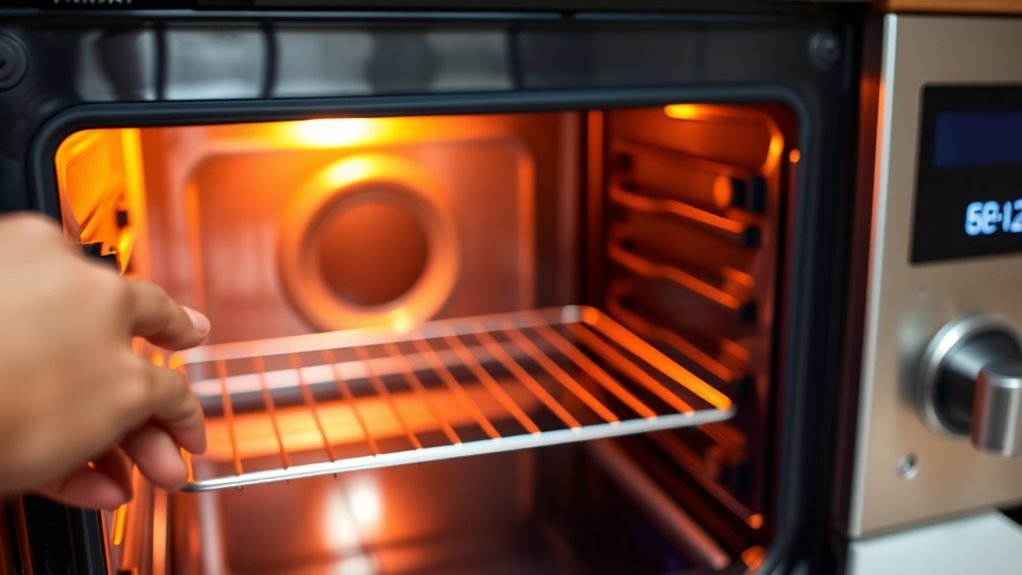
You need to know when your oven has reached the right temperature to start cooking. Check the visual indicator or listen for a signal if your oven has one. Using a thermometer can give you the most accurate reading, ensuring your food cooks perfectly. Monitoring oven temperature accurately is essential for consistent results.
Visual Oven Indicator
A visual oven indicator is one of the easiest ways to tell when your oven has reached the desired temperature. It provides a quick, reliable cue for when the oven is preheated, helping you avoid guesswork. Keep in mind, for ideal temperature accuracy, you should trust the indicator rather than relying solely on preheat duration estimates. To guarantee your oven is ready:
- Look for a steady indicator light or a digital display confirming the set temperature.
- Check if the indicator confirms the preheat cycle is complete.
- Observe any color changes or blinking signals that indicate readiness.
- Cross-reference the indicator with your oven’s manual for specific signals.
- Proper oven tuning, similar to Volkswagen Tuning, ensures consistent and efficient performance, highlighting the importance of accurate preheating.
Using the visual indicator ensures proper preheating, promoting consistent results and safe cooking.
Using a Thermometer
While visual indicators are helpful, using a thermometer provides a precise way to confirm your oven’s temperature. You should regularly check your thermometer calibration, as inaccurate readings can lead to improperly cooked food. Place the thermometer in the center of the oven for the most accurate measurement. Once your oven reaches the desired temperature, wait a few extra minutes to ensure oven temperature accuracy before placing your food inside. If your thermometer consistently reads off, consider recalibrating or replacing it. Relying solely on visual cues can be misleading, so a thermometer helps you recognize exactly when your oven is ready to cook. This practice ensures better results and reduces the risk of under- or over-cooking your dishes. Oven calibration is essential for maintaining accuracy over time.
Frequently Asked Questions
Can Preheating Damage My Oven or Reduce Its Lifespan?
Preheating your oven doesn’t damage it or shorten its lifespan if you follow proper oven maintenance. In fact, preheating guarantees your food cooks evenly and efficiently, boosting energy efficiency. Just avoid repeatedly preheating for no reason, as unnecessary cycles can wear components over time. Regular cleaning and maintenance help your oven stay in top shape, allowing safe preheating without risking damage or reducing its durability.
Is It Necessary to Preheat for All Types of Baked Goods?
Think of your oven as a trusty spaceship, needing proper launch prep. You don’t always need to preheat for every baked good, but for most, it’s essential to reach the right baking temperature. Proper oven calibration guarantees consistent results, whether you’re baking cookies or bread. Skipping preheat can cause uneven baking, so check your oven’s calibration and preheat when necessary to achieve perfect, reliable outcomes every time.
How Does Altitude Affect Oven Preheating Times?
At higher altitudes, you should expect longer preheat durations because the thinner air affects oven heating. Altitude adjustments are essential, so increase your preheat time by a few minutes depending on your elevation. This ensures your oven reaches the proper temperature for baking. Keep in mind, making these adjustments helps prevent undercooked baked goods and guarantees consistent results, especially when baking at elevations above 3,000 feet.
Do Different Oven Brands Have Varying Preheating Requirements?
Yes, different oven brands can have varying preheat durations due to differences in oven calibration. Some models heat up faster or slower, so you might need to adjust your preheat time accordingly. Always check your oven’s manual for recommended preheating instructions, and keep in mind that calibration issues can affect how long it takes to reach the desired temperature, ensuring your dishes turn out perfect.
What Are the Signs My Oven Is Malfunctioning During Preheat?
If your oven isn’t reaching the set temperature, if the heating elements glow unevenly or not at all, or if the oven takes unusually long to preheat, it’s a sign of malfunction. You might also notice inconsistent heat distribution or strange noises. These issues indicate your oven’s temperature isn’t stable, and the heating elements may be faulty. Don’t ignore these signs—address them promptly to ensure safe and efficient cooking.
Conclusion
Now that you know the truths behind oven preheating, you’ll never look at your kitchen the same way. But what if the real secret to perfect cooking lies in the moment you think your oven’s ready? Stay alert, because mastering preheat timing could be the key to unleashing culinary perfection—or a surprising mistake. Are you prepared to discover what’s truly at stake when you press that start button? The answer might just change everything.
